Eduard 1/48 F6F-5 Hellcat
|
KIT #: |
? |
|
PRICE: |
$
|
|
DECALS: |
Five options |
|
REVIEWER: |
Tom Cleaver |
|
NOTES: |
|
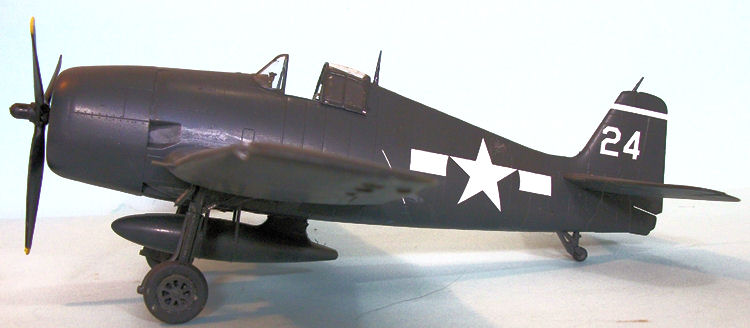
There are plenty of articles here on the site about the Hellcat for those
who need the aircraft’s history.
This is part of my Air Group 15 project, and commemorates the story of the
Navy’s youngest ace, Ensign Clarence “Spike” Borley of VF-15, who has been one
of my major contributors to the history of Air Group 15 I am writing.
Ensign Borley Survives a
Typhoon:
Pearl Harbor
found 17 year old “Spike” Borley working with his father on the “back 40" of the
family ranch outside
Yakima,
Washington.
He only learned of
Pearl Harbor
that evening when a neighbor dropped by.
As he recalled, “I knew my life had changed forever, though I wasn’t sure
how. I knew I would be involved in
this once I graduated from high school in the spring.”
Borley was very interested in aviation. Having seen the movie “Dive
Bomber” that fall when it played the local theater in town, he wanted to be
involved in naval aviation. At the
time that meant having two years of college as a minimum, as he had discovered,
and he didn’t see how he would get that in a war.
That spring, however, he heard that the Navy had a new program, and if an
18-year old high school graduate could pass the test high enough and demonstrate
college-level knowledge, they could be accepted for flight training.
That July, after his 18th birthday, Spike took the bus to
Seattle
and took the test, which he passed.
The Navy wanted him for the V-5 program, and he was sent home to await orders.
“I waited and waited and waited, and finally they came the week before
Thanksgiving, ordering me to report the first week of January.
I thought it was the best Christmas present ever.
Little did I know!”
Borley went through flight training in 1943 at Corpus Christi, and later
at Pensacola, where he qualified for fighters and was trained on the Hellcat.
In March 1944, he received orders to report to Air Group 15 for service
in Fighting 15, which was then in
Hawaii.
When he arrived, he found the unit had been removed from the carrier
Hornet and sent to NAAS Puuneme, on the
island
of
Maui.
“When I got there, I was surprised at the attitude in the squadron.
These guys were all acting like they were B’rer Rabbit and had been
thrown in the briar patch.” Indeed
they had been. Air Group 15 had
been kicked off the Hornet by her captain, Miles Browning, “the most
foul-tempered man in the Navy.”
LCDR David McCampbell, formerly the skipper of Fighting 15, was now the
CAG,
and the three squadrons trained six hours a day for six weeks.
In mid-April, McCampbell announced they had orders to join the USS Essex
when she arrived in
Hawaii
at the end of April. It would be a
momentous pairing of ship and air group.
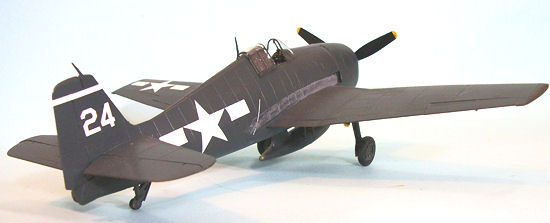 Air Group 15 flew aboard
Essex
off
Pearl Harbor
the first week of May, and the task group arrived at Majuro Atoll, the forward
base of the Fifth Fleet, on May 19.
A week later they were underway for an “out of town opening” with strikes
against Marcus and
Wake
Islands.
The aircrews were awakened by the Mid-Watch at 0230 and called to their
ready rooms before dawn on
May 19, 1944;
the target was
Marcus
Island.
Many, like Ensign Spike Borley, had been unable to sleep the night before
as they contemplated the coming dawn when they would discover personally what
air combat was about. The pilots of
Satan’s Playmates as VF-15 called itself, were the first to receive a
combat briefing by Air Group Commander McCampbell.
Sixty-eight years later, Borley would recall that “you could cut the
tension in the ready room with a knife that morning.
McCampbell stood up and told us the bluest joke I had ever heard in my
life to that time. It was dirty as
could be and funny as hell, and just broke everyone up with laughter.
After that, the tension was gone and we were ready to listen. Those jokes
became a tradition of pre-strike briefings for the rest of the cruise, and he
never repeated himself.”
Air Group 15 flew aboard
Essex
off
Pearl Harbor
the first week of May, and the task group arrived at Majuro Atoll, the forward
base of the Fifth Fleet, on May 19.
A week later they were underway for an “out of town opening” with strikes
against Marcus and
Wake
Islands.
The aircrews were awakened by the Mid-Watch at 0230 and called to their
ready rooms before dawn on
May 19, 1944;
the target was
Marcus
Island.
Many, like Ensign Spike Borley, had been unable to sleep the night before
as they contemplated the coming dawn when they would discover personally what
air combat was about. The pilots of
Satan’s Playmates as VF-15 called itself, were the first to receive a
combat briefing by Air Group Commander McCampbell.
Sixty-eight years later, Borley would recall that “you could cut the
tension in the ready room with a knife that morning.
McCampbell stood up and told us the bluest joke I had ever heard in my
life to that time. It was dirty as
could be and funny as hell, and just broke everyone up with laughter.
After that, the tension was gone and we were ready to listen. Those jokes
became a tradition of pre-strike briefings for the rest of the cruise, and he
never repeated himself.”
Over the target, clouds obscured the island.
First in were the Hellcats, sweeping across the island at tree-top level
as they strafed anti-aircraft positions.
In the last four-plane division, Spike Borley had such a rush of
fear-driven adrenaline that he recalled it seemed they were flying over the
spitting guns at only 100 m.p.h. rather than the near 400 m.p.h. his airspeed
indicator told him he was really doing.
“The flak came up like big slow golf balls and then zipped past my canopy
like little rockets.” Only one
plane, a Helldiver, was lost but AG-15 had now been “blooded.”
On
June 6, 1944,
Task Force 58 stood out of Majuro, headed for the
Marianas
and a certain fleet action. The
first strikes came on June 11, with
Essex’s
task group headed to
Iwo Jima
on June 16 to put that base out of action and stop Japanese reinforcements.
They returned to the
Marianas
on June 18. Word was out: the
Japanese fleet was on the way.
Borley flew his first air combat mission as #4 of McCampbell’s division
on June 19, when the Hellcats were launched to meet the first of four Japanese
raids that day that would become known as “The Marianas Turkey Shoot.”
VF-15 commander Brewer and three divisions were already involved in an
all-out fight with the Japanese when McCampbell’s reinforcements arrived on the
scene. McCampbell, who had already scored three victories in previous fights,
demonstrated the skill that would make him the Navy’s Ace of Aces, when he
attacked a formation of Aiichi D4Y Judy dive bombers, shooting down five
through multiple passes to become the group’s first “ace in a day.”
Spike Borley was able to cling tenaciously to his leader, but he never
fired his guns. “I realized as we
dove into the attack that I had forgotten to charge my guns!”
It was an elmentary mistake, and Borley expected the “fair and balanced”
chewing out McCampbell was known for on their return.
“He asked me why I hadn’t fired, I told him, and he replied ‘That’s not
going to happen again, is it?’ ‘No sir!’ I replied, and it never did.”
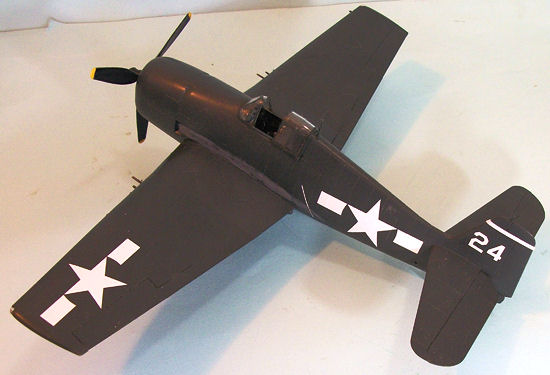 Borley flew on as a junior wingman through the rest of the
Marianas
campaign and then through the
Philippines
rampage initiated by Admiral Halsey when he took the carriers to sea as the
Third Fleet in September. After
decimating Japanese forces in the southern
Philippines,
Halsey was able to report that there were few Japanese forces on
Mindanao
and fewer on
Leyte.
Rather than invade
Mindanao
at the end of October, it was decided to hit
Leyte.
There was more softening up needed, to block the Japanese from bringing
in more aerial support from the
Home
Islands.
Task Force 38 anchored in the new forward base at Ulithi on October 4,
where they received new aircraft and replacement pilots.
Finally, there were enough F6F-5s in Fighting 15 to fly 4 plane flights
of either F6F-3 or F6F-5 Hellcats; mixing the two had proven difficult when
wingmen in war-weary Dash-3s tried to keep up with leaders in new Dash-5s.
Borley flew on as a junior wingman through the rest of the
Marianas
campaign and then through the
Philippines
rampage initiated by Admiral Halsey when he took the carriers to sea as the
Third Fleet in September. After
decimating Japanese forces in the southern
Philippines,
Halsey was able to report that there were few Japanese forces on
Mindanao
and fewer on
Leyte.
Rather than invade
Mindanao
at the end of October, it was decided to hit
Leyte.
There was more softening up needed, to block the Japanese from bringing
in more aerial support from the
Home
Islands.
Task Force 38 anchored in the new forward base at Ulithi on October 4,
where they received new aircraft and replacement pilots.
Finally, there were enough F6F-5s in Fighting 15 to fly 4 plane flights
of either F6F-3 or F6F-5 Hellcats; mixing the two had proven difficult when
wingmen in war-weary Dash-3s tried to keep up with leaders in new Dash-5s.
On October 6, Third Fleet and Task Force 38 sortied from Ulithi.
Their target was the
Ryukyu Islands,
the first part of the Japanese home territory to be attacked by carrier
aircraft. Nothing was known about
the islands, other than the main air bases were on the biggest island,
Okinawa.
There was no information on where airfields were located on the island
and no information on how many Japanese aircraft might be found, though it was
known that Okinawa was a major stopping point for Japanese Army and Navy
aircraft being funneled down to the Philippines from the Home Islands.
Task Force 38 was venturing into unknown territory.
By this time, life was not as easy on the carriers as legend would have
it. While the Navy is traditionally held to have the best food in the military,
the ship had last taken aboard fresh food in
Hawaii
back in early May. Since the last of that had been consumed some six weeks after
departing, most food aboard ship was canned. As Borley recalled, “In the
wardroom, we were reduced to a breakfast of dehydrated reconstituted eggs,
canned beets and canned asparagus.
We could also have toast, but there were weevils in the bread and it was hard.
You could tap it on your plate and watch the bugs fall out, which had a
negative effect on your appetite.
Dinner was more beets and asparagus, with spam.
There are only so many ways to cook spam, and most of us were at the
point where the only reason we were eating was to avoid hunger pangs.”
The night of October 9, Task Force 38 began its run-in toward
Okinawa.
The first strike was launched by
Essex
at 0530, with
CAG
McCampbell leading a sweep composed of fourteen VF-15 fighters headed by Jim
Rigg, with 16 VF-19 Hellcats from
Lexington,
to hit
Okinawa.
Two strikes by Helldivers and Avengers would follow almost immediately.
The fighters arrived over Yontan North Airfield in central
Okinawa
at dawn, where they caught twelve Japanese aircraft preparing to take off, and
burned all. Heading to Yontan South
Airfield, they found the enemy aircraft still in their revetments.
Anti-aircraft fire was fierce but no one was shot down.
An hour later, the second strike went out, with Lieutenant Bert Morris
leading twelve
Essex
Hellcats armed with bombs and rockets.
Finding no Japanese aircraft airborne, they attacked shipping off
Naha
Port,
sinking one 8,000 ton freighter and three smaller freighters, two of which were
moored together and went up in one spectacular explosion when ammunition in
their cargo was hit. As the
Hellcats pulled off the target, Japanese fighters arrived.
Morris, known to moviegoers as the actor Wayne Morris, went after a
Tony, shooting it into the water for his fifth victory; he was now the only
real “Hollywood
Ace.” Borley spotted five enemy aircraft below. He followed his Division Leader
down and attacked one Zeke that banked sharply to the right; instead of
breaking off, the Zeke pilot came around and attacked Borley head-on.
Firing several bursts, he set the enemy aircraft afire as it headed
toward the water below for his first victory.
By the end of the day, Task Force 38 claimed 100 Japanese aircraft shot
down, with Fighting 15 scoring 23.
The Yontan airfield complex had been virtually annihilated, while four ships
were sunk including the 10,000 ton submarine tender Jinggyo, thirteen
torpedo boats, two midget submarines, and twenty-two other vessels.
American losses were 21 aircraft, but only five pilots and four aircrew.
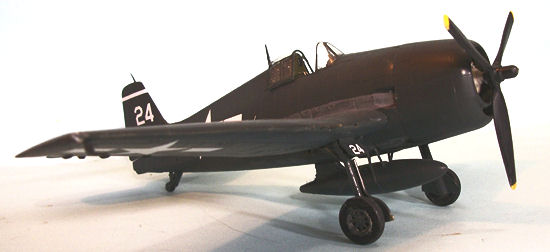 Task Force 38 split apart as they departed the Ryukyus, with two task
groups heading south to hit Aparri Airfield on northern Luzon, while Essex’s
Task Group 38.3 refueled on October 11. The target on October 12 was
Formosa.
As Spike Borley recalled the pre-dawn strike briefing, “The only
intelligence material they had on
Formosa
was photographs taken by submarines, so there really wasn’t anything useful.
We were told there were as many as twenty-four enemy airfields and there
could be more than 300 enemy aircraft on the island.”
Task Force 38 split apart as they departed the Ryukyus, with two task
groups heading south to hit Aparri Airfield on northern Luzon, while Essex’s
Task Group 38.3 refueled on October 11. The target on October 12 was
Formosa.
As Spike Borley recalled the pre-dawn strike briefing, “The only
intelligence material they had on
Formosa
was photographs taken by submarines, so there really wasn’t anything useful.
We were told there were as many as twenty-four enemy airfields and there
could be more than 300 enemy aircraft on the island.”
Borley had a bad feeling about the mission as he climbed aboard the dark
blue F6F-5 Hellcat with the side number 24.
“It was as dark as
midnight,
there weren’t any lights, the sea was running pretty strong.
None of us had any night flying training, and we were going to have to go
on instruments as soon as we were off the ship, then rendezvous in the darkness
to go in and hit a target we knew nothing about. It felt like a real crap shoot
to me.”
The Hellcats of the fighter sweep were launched as the task group steamed
150 miles northeast of Formosa, with sixteen Fighting 15 Hellcats led by Rigg
set to rendezvous with sixteen Fighting 19 Hellcats from the Lexington.
Borley was able to join on his Section Leader and the two were able to
join with Lieutenant Berree, their Division Leader.
All four were flying F6F-5 Hellcats, which equipped about one-third of
Fighting 15 by then as Borley recalled. About twenty minutes after departure,
Berree reported his fuel pump was failing and he aborted the mission, returning
to
Essex
with his wingman. Borley and his
Section Leader decided to continue on as a two-ship section.
“I really wanted to find a mechanical fault with my airplane,” Borley
recalled, “but unfortunately everything was working perfectly.”
Fighting 15 was headed toward the west coast of
Formosa,
with the
port
of
Kaohsiung
and the
Pescadore
Islands
as their target. As the sky got
brighter, the weather was revealed as grim, with low clouds and a chop on the
waves below (Unknown to the Americans, a typhoon was making its way across the
East China Sea toward the island).
At 0645, the coast of
Formosa
appeared on the horizon.
The Americans didn’t know where their targets really were, and were
dodging in and out of heavy clouds and rain.
Air battles developed suddenly, with Japanese fighters diving out of the
clouds. The Americans were
outnumbered, but the quality of the Japanese pilots was so poor that air
supremacy was quickly established.
Borley and his Section Leader took part in strafing two airfields they
discovered outside
Kaohsiung.
They then ran into a fight between several F6Fs and a large formation of
Japanese fighters. Borley described
the fight thus: “I did not get into
any dogfights, but rather I was able to see and hit four different airplanes
without engaging in a fight.” In
quick succession, the 20-year old pilot shot down a Zeke, a Tojo
and two Oscars.
He was now an ace; in fact, he was the youngest American ace, having only
turned 20 the previous July 27. The two pilots decided they’d had enough for one
mission; spotting a group of Hellcats flying eastwards, they joined up for the
flight home. Things were far from
over. “Sixteen of us were returning
to the ship when we saw Japanese aircraft taking off from an airfield and we
went in to strafe them,” Borley remembered.
“I went after an anti-aircraft gun, but my Hellcat got hit in the engine
and caught fire. I was doing about
400 mph when the engine stopped, so I decided I would stretch my glide to the
ocean, which was about four or five miles away.
I flew directly over
Kaohsiung
at an altitude under 2,000 feet, getting shot at all the time but they didn’t
hit me, then I got out to sea. I was about half a mile from shore, setting up to
ditch, when the airplane stalled at 135 mph and hit the water from an altitude
of about 100 feet. It broke in half and sank immediately. By the time I managed
to get out of the cockpit underwater and get to the surface, the tail was going
down. I still had my parachute with my raft attached, but I was so close to
shore I was afraid of being spotted, so I dropped my parachute and raft and
stayed in the water with only my Mae West. Shrapnel from all the anti-aircraft
guns ashore was coming down all around me like a hail storm.
I didn’t know it at the time, but I was also in the middle of a
minefield.”
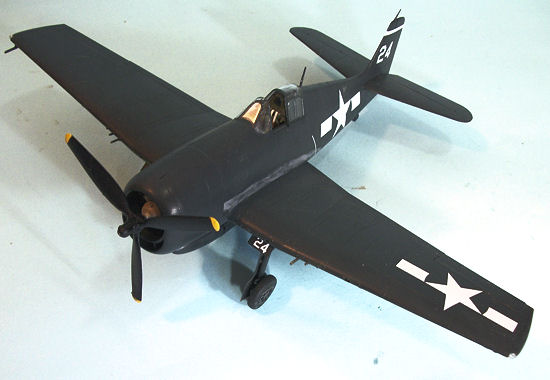 Over the next three days, while Task Force 38 fought the epic
Battle
of
Formosa,
Ensign Borley began an epic battle of survival against the enemy and the
elements. He realized the tide was
drifting him toward shore, two miles distant, and began swimming toward the open
sea. “About half an hour later, a sampan came out of the harbor, headed almost
directly toward me. After an hour,
they came closer; they were probably Chinese fishermen.
They were so close I let the air out of my life preserver so they
wouldn’t see me, but they ended up about 5-10 yards from me and I was sure they
would spot me, so I pulled out my .38 and shot them - one fell overboard and the
other fell onto the deck. The
sampan drifted off.”
Over the next three days, while Task Force 38 fought the epic
Battle
of
Formosa,
Ensign Borley began an epic battle of survival against the enemy and the
elements. He realized the tide was
drifting him toward shore, two miles distant, and began swimming toward the open
sea. “About half an hour later, a sampan came out of the harbor, headed almost
directly toward me. After an hour,
they came closer; they were probably Chinese fishermen.
They were so close I let the air out of my life preserver so they
wouldn’t see me, but they ended up about 5-10 yards from me and I was sure they
would spot me, so I pulled out my .38 and shot them - one fell overboard and the
other fell onto the deck. The
sampan drifted off.”
Throughout the day, strikes went in from the fleet.
A fourth strike went out at 1400 to hit Nikosho Airfield.
They also bombed and strafed several ships they found offshore, which was
fortunate for Borley. “Later in the
afternoon, a Japanese patrol boat came out of the harbor.
It was attacked by four Hellcats that strafed it.
This was so close to me that I popped my dye marker so they would see me.
The leader came around and dropped gear and flaps to slow down and opened his
canopy and threw his raft down to me.
I managed to deploy it and get in and started paddling.”
At dawn the next morning in his raft now five miles offshore, Borley
watched American planes overhead, the first strike of the day from the Essex,
led by his skipper, Jim Rigg. “I had managed to get offshore far enough that
they weren’t looking for me, but now the current was working against me,
carrying me along the coast.” All
day October 13, Borley drifted offshore, watching the numerous American air
strikes. He took stock of his
supplies and decided to use as little water and eat as little of his emergency
rations as possible. He took out
the fishing line from the emergency kit and trailed it over the side, but was
unsuccessful in catching anything.
The next day, he watched 100 B-29s from
China
bomb
Kaohsiung.
The wind got stronger.
That night, Borley survived one of the most terrifying experiences
possible at sea. “That night and the next day and night I went through a
typhoon. I was tossed overboard, and when I got back into the raft, I discovered
that the water and food were now missing.
I was thrown out of the raft several times but managed to get back in it
each time. The waves got progressively larger as I got closer to the eye of the
storm, and waves were coming from all directions. I would be halfway up one
wave, holding on to go over the top into the lee, and would get hit by a wave
coming from the side. I went
through the eye of the typhoon that night, thirty minutes of calm and then into
the wind and waves on the other side.(As an aside, Yours Truly was once foolish
enough at age 19 to disobey the order “Stand clear of the weather decks” while
on a typhoon evasion, and went up to the signal bridge, the highest deck aboard
ship. My buddy and I stepped
outside to see mountainous seas overhanging us as green water came over the bow,
which was 70 feet above the waterline.
The wind nearly blew us overboard in the 30 seconds it took us to get
back inside. I cannot imagine what
it would have been like to be in that ocean in a rubber raft; years later I was
told by a weather scientist that I had been staring into the energy equivalent
of the
Hiroshima
A-bomb.)
So far as is known, Borley is the only individual to ever survive a
typhoon in a rubber life raft. By
October 16, he was alone in the Taiwan Straits, out of sight of any land. He was
now at what he believed was the end. “By that fifth day, I was hallucinating
from lack of sleep in all this time and no food, and there was no land in the
direction the storm had taken me. I
was afraid I would pass out and a passing Japanese ship might find me and
capture me. I had decided that I
would not let myself be taken prisoner, since I knew about the coming invasion
of the
Philippines,
when and where it would be. In the
middle of these hallucinations, I took out my gun and decided to kill myself.
I put the gun to my head, and then thought that it had been in the water
and might misfire, so I should test it first.
I lowered the gun and shot it and it worked.
The sound of the shot brought me back to reality and I decided not to
commit suicide.”
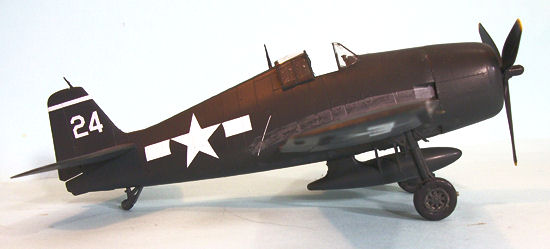 Late that afternoon Borley looked out to see a dark shape on the horizon.
“As it got closer, I could tell it was a submarine.
I was sure it must be Japanese out in these waters, and then I was ready
again to shoot it out and kill myself if necessary.
The submarine got closer, and as I brought my pistol up, I heard a very
American voice through a megaphone tell me ‘Put down that gun!’ I threw the gun
down and raised my hands.” The
submarine was USS Sawfish (SS-276), which had been assigned as one of the
lifeguard submarines for the
Formosa
strikes. They had been searching for Borley, but in the wrong area, and had
finally given up hope. They had
then been ordered to look for a B-29 crew, which had given incorrect coordinates
when they went down, which brought the submarine into this part of the
Formosa Strait.
Sawfish had been ten minutes from submerging and leaving the area
when they had spotted Borley’s raft; the meeting at sea was entirely fortuitous
since he had been blown 75 miles from his last reported position. “They came
close alongside and put a cargo net over for me to climb up, but I was too weak
and so a couple of sailors came down and got me and brought me aboard.
I was so badly sunburned that the captain, Commander Alan B. Banister,
couldn’t tell I was an American and asked if I was Japanese.
I managed to croak I was American and pulled out my dog tags.
They took those and checked me out.
I was taken below and they gave me a little water and food and increased
that over the next two days as I recovered. My head was so badly sunburned I
could pull off the skin.”
Late that afternoon Borley looked out to see a dark shape on the horizon.
“As it got closer, I could tell it was a submarine.
I was sure it must be Japanese out in these waters, and then I was ready
again to shoot it out and kill myself if necessary.
The submarine got closer, and as I brought my pistol up, I heard a very
American voice through a megaphone tell me ‘Put down that gun!’ I threw the gun
down and raised my hands.” The
submarine was USS Sawfish (SS-276), which had been assigned as one of the
lifeguard submarines for the
Formosa
strikes. They had been searching for Borley, but in the wrong area, and had
finally given up hope. They had
then been ordered to look for a B-29 crew, which had given incorrect coordinates
when they went down, which brought the submarine into this part of the
Formosa Strait.
Sawfish had been ten minutes from submerging and leaving the area
when they had spotted Borley’s raft; the meeting at sea was entirely fortuitous
since he had been blown 75 miles from his last reported position. “They came
close alongside and put a cargo net over for me to climb up, but I was too weak
and so a couple of sailors came down and got me and brought me aboard.
I was so badly sunburned that the captain, Commander Alan B. Banister,
couldn’t tell I was an American and asked if I was Japanese.
I managed to croak I was American and pulled out my dog tags.
They took those and checked me out.
I was taken below and they gave me a little water and food and increased
that over the next two days as I recovered. My head was so badly sunburned I
could pull off the skin.”
The usual procedure when rescuing an airman was for the submarine to
rendezvous with surface forces and return the flier as soon as possible.
However, Task Force 38 had now left the
area. Sawfish was the lead
boat of a three-submarine wolf pack that had just left Majuro two weeks
previously. The decision was made
to keep Borley aboard and continue the patrol.
“Since they were just out of port, the food was really delicious,
especially coming from the bad chow on the
Essex,”
he remembered. As a result of this decision, over the course of the next several
weeks, Borley would see almost as much submarine combat as he had aerial combat.
Captain Banister believed there were no passengers aboard a submarine; as
soon as Borley was recovered from his ordeal he learned to be a control room
watch stander. “The second day I was aboard, the Sawfish attacked a
Japanese convoy. A Japanese
destroyer depth-charged us for an hour.
I was sure I was finally going to die after surviving being shot down and
the typhoon. We were also
depth-charged a second time a week later and it wasn’t any better.” On November
9, Sawfish put into Majuro and deposited Borley with Naval authorities.
Over the next two weeks, he hitchhiked and hop-scotched across the
Western Pacific, arriving in
Hawaii
in time to meet Air Group 15 when they arrived home aboard the USS
Bunker Hill.
Ten years later, then-LCDR Borley was stationed on
Formosa,
working with the Nationalist Chinese Navy, and flying out of the same airfield
he had strafed in October 1944. “I
could look out from the verandah of my house in Kaiohsiung, and see the very
spot in the ocean offshore where I had ditched at sea that day.”
For reviews of what is in the box and how this kit builds, check out
this
review.
This is one of the easiest-assembling models there is, and the longest part of
the process is putting all the really nice photo-etch detail into the cockpit.
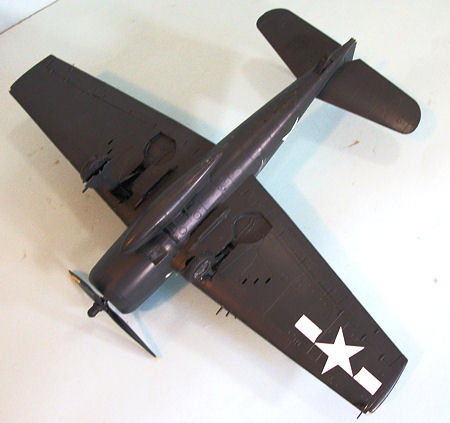 With the F6F-5 Hellcat, you can paint it any color you like, so long as
that color is
Glossy
Sea
Blue. I used Gunze-Sangyo “Midnight
Blue” for this model, and followed up with a coat of Xtracrylix Glear Gloss.
With the F6F-5 Hellcat, you can paint it any color you like, so long as
that color is
Glossy
Sea
Blue. I used Gunze-Sangyo “Midnight
Blue” for this model, and followed up with a coat of Xtracrylix Glear Gloss.
I used some Micro-Scale decals for the national insignia, and white
numbers off an Xtradecals sheet to do Number 24, the Hellcat Spike Borley was
flying when he was shot down. I had
used the white stenciling on the earlier kit I did from this box, so left those
off this model. I followed up with
a coat of Xtracrylix Clear Satin.
I attached the landing gear, then mixed Xtrcrylix Clear Flat and Clear
Satin 50-50 to get the kind of “semi-semigloss” finish that
GSB
Hellcats had after a few weeks of hard use at sea.
I then brush applied some grey paint for the exhaust.
I unmasked the canopy and windscreen and mounted it in the open position,
and attached the prop.
I’ve said it before and will say it again: Eduard’s Hellcat is a great
kit, and an easy model that will give an outstanding representation of this
classic Navy fighter. It’s easy
enough that any modeler of any ability can create a great model with this kit.
Highly recommended.
Tom Cleaver
November 2012
Review Kit courtesy of
Eduard.
If you would like your product reviewed fairly and
fairly quickly, please
contact
the editor or see other details in the
Note to
Contributors.
Back to the Main Page
Back to the Review
Index Page


 Air Group 15 flew aboard
Air Group 15 flew aboard  Borley flew on as a junior wingman through the rest of the
Borley flew on as a junior wingman through the rest of the  Task Force 38 split apart as they departed the Ryukyus, with two task
groups heading south to hit Aparri Airfield on northern Luzon, while Essex’s
Task Group 38.3 refueled on October 11. The target on October 12 was
Task Force 38 split apart as they departed the Ryukyus, with two task
groups heading south to hit Aparri Airfield on northern Luzon, while Essex’s
Task Group 38.3 refueled on October 11. The target on October 12 was  Over the next three days, while Task Force 38 fought the epic
Over the next three days, while Task Force 38 fought the epic  Late that afternoon Borley looked out to see a dark shape on the horizon.
“As it got closer, I could tell it was a submarine.
I was sure it must be Japanese out in these waters, and then I was ready
again to shoot it out and kill myself if necessary.
The submarine got closer, and as I brought my pistol up, I heard a very
American voice through a megaphone tell me ‘Put down that gun!’ I threw the gun
down and raised my hands.” The
submarine was USS Sawfish (SS-276), which had been assigned as one of the
lifeguard submarines for the
Late that afternoon Borley looked out to see a dark shape on the horizon.
“As it got closer, I could tell it was a submarine.
I was sure it must be Japanese out in these waters, and then I was ready
again to shoot it out and kill myself if necessary.
The submarine got closer, and as I brought my pistol up, I heard a very
American voice through a megaphone tell me ‘Put down that gun!’ I threw the gun
down and raised my hands.” The
submarine was USS Sawfish (SS-276), which had been assigned as one of the
lifeguard submarines for the 